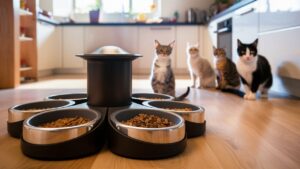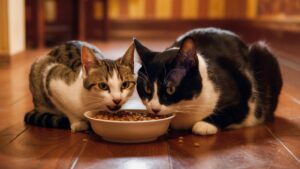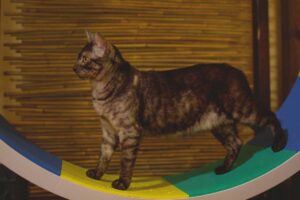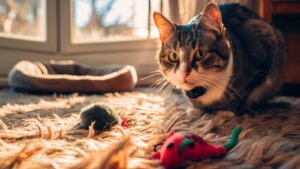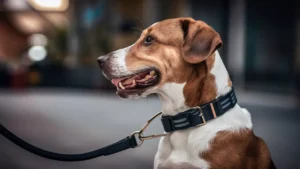An indoor cat should typically eat around 1/4 to 1/2 cup of dry food per day. Indoor cats have a lower activity level compared to outdoor cats, so they require less food to maintain a healthy weight.
Recommended Best Dry Cat Food 2025
| Recommendation | Product |
| Best Overall | Purina ONE Natural Dry Cat Food |
| Popular Choice | Blue Buffalo Grain-Free Natural Dry Food |
| Best Value | Purina Pro Plan High Protein Cat Food |
| Best Budget | Meow Mix Original Choice Dry Cat Food |
| Another Excellent Pick | Purina Friskies Dry Cat Food |
It’s important to consult with your veterinarian to determine the exact amount of dry food that is appropriate for your specific cat, as factors such as age, weight, and overall health should be taken into consideration. Feeding guidelines provided by the cat food manufacturer can also serve as a useful starting point, but adjustments may need to be made based on your cat’s individual needs.
Ensuring that your indoor cat has access to fresh water at all times is equally important for their overall well-being.
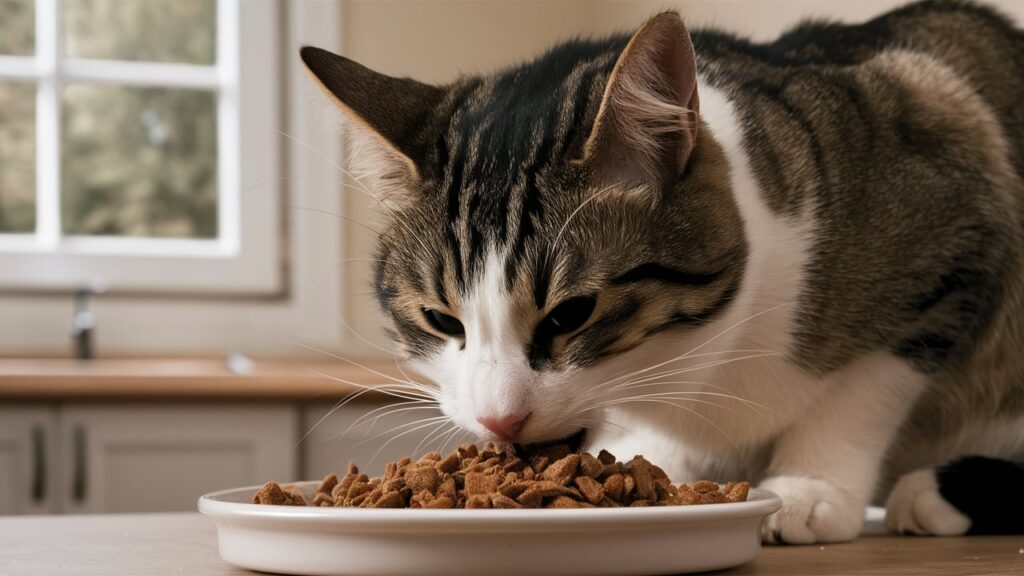
Cat Nutrition Basics
Indoor cats should typically eat about 1/4 to 1/2 cup of dry food per day, depending on their weight and activity level. It’s important to consult with your veterinarian to determine the appropriate amount for your specific cat’s needs. Remember to provide fresh water at all times and monitor your cat’s weight to ensure they maintain a healthy body condition.
Caloric Needs Of Indoor Cats
Indoor cats have specific caloric needs that differ from outdoor cats due to their lower activity levels. It’s crucial to understand these needs to ensure your feline friend maintains a healthy weight.
- Adult indoor cats generally require around 20 calories per pound of body weight per day.
- Senior indoor cats may need fewer calories, while kittens and lactating mother cats require more.
Understanding Cat Food Labels
When it comes to choosing the right food for your indoor cat, understanding cat food labels is essential. Here’s what to look for:
- Protein: Look for a high protein content, as cats are obligate carnivores and require a diet rich in animal-based protein.
- Fat: Opt for moderate fat content to support your cat’s energy needs without leading to obesity.
- Carbohydrates: Cats have limited carbohydrate requirements, so choose foods with minimal fillers or unnecessary carbohydrates.
- Vitamins and Minerals: Ensure the food contains essential nutrients such as taurine, omega-3 fatty acids, and vitamins A, D, and E.
Dry Food Advantages
Indoor cats should eat about 1/4 to 1/2 cup of dry food per day, depending on their size and activity level. Dry food has the advantage of being convenient, helping to maintain dental health, and providing balanced nutrition for indoor cats.
Dry food, also known as kibble, offers several advantages for feeding your indoor cat. From dental health benefits to convenience for owners, here are some reasons why dry food can be a great option:
Dental Health Benefits
Dry cat food can help promote dental health in your indoor cat. The crunchy texture of kibble helps to scrape off plaque and tartar from your cat’s teeth, reducing the risk of dental issues such as gum disease and tooth decay. Additionally, some dry cat food brands may contain specific ingredients that contribute to dental health, such as added enzymes or abrasive particles. By incorporating dry food into your cat’s diet, you can contribute to their overall oral hygiene.
Convenience For Owners
Feeding your indoor cat dry food offers convenience for you as an owner. Unlike wet food, which needs to be refrigerated and consumed within a short period, dry food can be left out for your cat to graze throughout the day. This is especially beneficial for busy pet owners or those who are away from home for extended periods. With dry food, you can easily measure out the recommended portion for your cat and leave it in their bowl, knowing that they have access to food whenever they need it.
Moreover, dry cat food has a longer shelf life compared to wet food, making it easier to store and manage. You can buy larger quantities of dry food and keep them in airtight containers, ensuring that your cat always has a fresh and readily available food source. This not only saves you time but also reduces the frequency of trips to the store.
In conclusion, dry cat food offers several advantages for both your cat’s dental health and your own convenience as an owner. By incorporating dry food into your indoor cat’s diet, you can help maintain their oral hygiene while enjoying the ease of feeding.
Calculating Portion Sizes
When it comes to feeding your indoor cat, it’s important to calculate the right portion sizes to ensure they maintain a healthy weight and receive the nutrition they need. Calculating portion sizes involves considering your cat’s weight and activity levels to determine the appropriate amount of dry food they should eat each day.
Using Cat Weight As A Guide
To calculate the portion size for your indoor cat, start by considering their weight. An average adult cat typically weighs between 8 to 10 pounds. For every 5 pounds of body weight, a cat generally requires around 1/4 to 1/3 cup of dry food per day. So, for an 8-pound cat, you would aim to provide approximately 1/3 to 1/2 cup of dry food daily.
Adjusting For Activity Levels
In addition to weight, it’s essential to take your cat’s activity level into account when determining portion sizes. A more active cat may require a slightly larger portion of food, while a sedentary cat may need a smaller amount to prevent overeating and weight gain. Keep an eye on your cat’s body condition and adjust their portion sizes accordingly to ensure they remain at a healthy weight.
Feeding Frequency
To maintain a healthy weight, an indoor cat should eat about 1/4 to 1/2 cup of dry food per day, divided into two meals. Adjust the amount based on your cat’s age, weight, and activity level. It’s important to monitor your cat’s body condition and consult with a veterinarian for personalized feeding recommendations.
Meal Feeding Vs. Free-feeding
When it comes to feeding your indoor cat, one important aspect to consider is the feeding frequency. Should you opt for meal feeding or free-feeding? Let’s take a closer look at each option.
Meal Feeding
Meal feeding involves providing specific meals for your cat at designated times throughout the day. This method allows you to have more control over your cat’s food intake and ensures that they are receiving the appropriate portion sizes.
Here are some benefits of meal feeding:
1. Portion Control: By providing set meals, you can easily monitor and control the amount of food your cat consumes. This can be particularly beneficial for cats that tend to overeat or struggle with weight management.
2. Routine: Meal feeding establishes a consistent routine for your cat, which can be beneficial for their overall well-being and digestion. Cats are creatures of habit, and having a regular feeding schedule can help them feel more secure and comfortable.
3. Bonding Time: Meal feeding allows for more interaction and bonding between you and your cat. It provides an opportunity for you to engage with your feline friend during meal times, strengthening your relationship.
Free-feeding
Free-feeding involves leaving a bowl of food out for your cat to eat at their leisure. This method allows your cat to graze throughout the day and eat whenever they feel hungry.
Here are some considerations for free-feeding:
1. Convenience: Free-feeding can be convenient for busy pet owners or households with multiple cats. It eliminates the need for strict feeding schedules and allows your cat to eat whenever they desire.
2. Self-Regulation: Some cats are good at self-regulating their food intake and will only eat what they need. Free-feeding can be suitable for cats that maintain a healthy weight and do not overeat.
However, it’s important to note that free-feeding may not be suitable for all cats. Some cats may be prone to overeating or have specific dietary requirements that necessitate portion control.
Portion Control Tips
If you choose to meal feed your indoor cat, it’s essential to establish proper portion control. Here are some tips to help you ensure your cat is receiving the appropriate amount of food:
1. Consult with your veterinarian: Your vet can provide guidance on the appropriate portion sizes for your cat based on their age, weight, and overall health.
2. Read the feeding guidelines: Most cat food brands provide recommended feeding guidelines on their packaging. These guidelines are a good starting point, but remember that individual cats may have unique needs.
3. Monitor your cat’s weight: Regularly check your cat’s weight to ensure they are maintaining a healthy body condition. Adjust the portion sizes accordingly if needed.
4. Treats in moderation: If you give your cat treats, be mindful of their calorie content and factor it into their daily food intake. Treats should only make up a small portion of their overall diet.
Remember, each cat is unique, and their dietary needs may vary. It’s important to observe your cat’s behavior, weight, and overall health to determine the most suitable feeding frequency and portion sizes for them.
Special Dietary Considerations
Determining how much dry food an indoor cat should eat per day depends on several factors, including the cat’s age, weight, activity level, and any special dietary considerations. It’s best to consult with a veterinarian to create a personalized feeding plan that meets your cat’s nutritional needs.
Age-specific Needs
When it comes to feeding your indoor cat, age is a crucial factor to consider. Young kittens have different dietary needs than adult cats or senior cats. Kittens require more protein and calories to support their growing bodies, while senior cats may need a diet that is lower in calories to maintain a healthy weight.
For kittens, it is recommended to feed them small meals throughout the day, ideally four to six times a day. As they grow older, you can gradually decrease the frequency of their meals until they reach adulthood. Adult cats typically require two meals a day, while senior cats may benefit from smaller, more frequent meals to aid digestion.
Health-related Adjustments
In addition to age, certain health conditions may require adjustments to your indoor cat’s diet. For example, cats with diabetes may need a diet that is low in carbohydrates to help regulate their blood sugar levels. Cats with urinary tract issues may benefit from a diet that is high in moisture to promote hydration and prevent the formation of crystals in their urine.
If your indoor cat has a health condition that requires a special diet, it is important to consult with your veterinarian to determine the best course of action. They can help you select a diet that is specifically tailored to your cat’s needs and monitor their progress over time.
Overall, it is essential to pay attention to your indoor cat’s dietary needs and make any necessary adjustments to ensure they are receiving the proper nutrition for their age and health status. By taking a proactive approach to their diet, you can help your indoor cat live a long, healthy, and happy life.
Monitoring Food Intake
When it comes to monitoring food intake, it’s important to consider how much dry food an indoor cat should eat in a day. Avoid overfeeding by following feeding guidelines and considering factors such as age, weight, and activity level to ensure a healthy diet for your furry friend.
Signs Of Overfeeding
When it comes to feeding your indoor cat, monitoring their food intake is crucial to ensure they maintain a healthy weight. Overfeeding can lead to obesity, which can cause numerous health problems for your feline friend. Some signs that your cat may be overfed include weight gain, lethargy, and difficulty grooming themselves.
To prevent overfeeding, it’s important to measure your cat’s food and stick to the recommended serving sizes based on their age, weight, and activity level. Avoid free-feeding your cat and instead, divide their daily food intake into multiple smaller meals throughout the day.
Importance Of Regular Weigh-ins
Regular weigh-ins are essential to monitor your cat’s weight and ensure they are not over or underfed. It’s recommended to weigh your cat at least once a month, and record their weight in a journal or spreadsheet to track their progress.
If you notice any significant changes in your cat’s weight, it’s important to consult with your veterinarian to rule out any underlying health issues that may be affecting their appetite or metabolism.
In addition to weigh-ins, pay attention to your cat’s body condition score (BCS), which is a visual assessment of their body composition. A healthy BCS should show a waistline when viewed from above, and you should be able to feel their ribs without excess fat covering them.
By monitoring your cat’s food intake and weight regularly, you can ensure they stay healthy and happy for years to come.
Transitioning To New Food Quantities
Transitioning to new food quantities can be tricky when it comes to determining how much dry food an indoor cat should eat in a day. It is important to consider the cat’s age, weight, and activity level to ensure they are getting the appropriate amount of food for their nutritional needs.
Consulting with a veterinarian can provide guidance on the ideal portion sizes to maintain a healthy diet for your feline friend.
When it comes to transitioning your indoor cat to new food quantities, it’s important to do so gradually to avoid any digestive issues or discomfort for your furry friend. Introducing changes gradually allows your cat’s digestive system to adapt to the new food and prevent any sudden changes in their diet. Here are some important steps to follow when transitioning your cat to new food quantities:
Introducing Changes Gradually
The first step in transitioning your indoor cat to new food quantities is to introduce the changes gradually. Start by mixing a small amount of the new food with their current food. This can be done by gradually increasing the proportion of the new food over a period of 7-10 days. For example, you can start with a ratio of 75% current food and 25% new food, and then gradually increase the amount of new food each day until you have completely switched to the new quantity.
By introducing changes gradually, you give your cat’s digestive system time to adjust to the new food and prevent any sudden changes that may cause digestive upset. It also allows your cat to slowly get accustomed to the new taste and texture of the food, increasing the likelihood of a successful transition.
Observing Your Cat’s Response
During the transition period, it’s important to closely observe your cat’s response to the new food quantities. Keep an eye out for any signs of digestive upset, such as vomiting, diarrhea, or a decrease in appetite. If you notice any of these symptoms, it may be an indication that the transition is happening too quickly, and you may need to slow down the process or consult with your veterinarian.
On the other hand, if your cat is adjusting well to the new food quantities and shows no signs of discomfort, you can continue with the transition as planned. It’s important to remember that every cat is unique, and their response to dietary changes may vary. Therefore, it’s crucial to pay attention to your cat’s individual needs and adjust the transition process accordingly.
By following these steps and gradually transitioning your indoor cat to new food quantities, you can ensure a smooth and successful transition without causing any unnecessary stress or digestive issues for your beloved feline companion.
Consulting With Professionals
Consulting with professionals is recommended to determine how much dry food an indoor cat should eat per day. Feeding guidelines vary based on the cat’s age, weight, and activity level. It is important to monitor their weight and adjust their food intake accordingly to maintain a healthy and balanced diet.
When To Speak To A Vet
If your indoor cat is struggling with weight management or showing signs of malnutrition, it’s essential to consult with a veterinarian. Additionally, if your cat has health conditions such as diabetes, kidney disease, or food allergies, a vet’s guidance is crucial in determining the appropriate amount of dry food to feed your cat.
Working With A Pet Nutritionist
For personalized advice on your indoor cat’s dietary needs, consider working with a pet nutritionist. A nutritionist can create a tailored meal plan and recommend the right portion size of dry food based on your cat’s age, weight, and activity level. This expert guidance can ensure that your cat receives the necessary nutrients while maintaining a healthy weight.
Frequently Asked Questions
How Much Dry Food Should An Indoor Cat Eat?
An indoor cat should eat about 1/4 to 1/2 cup of dry food per day, depending on its weight and activity level.
Is A Cup Of Dry Food A Day Too Much For A Cat?
A cup of dry food a day may be too much for a cat, depending on its size and activity level. Consult your veterinarian for personalized advice.
How Much To Feed A 10 Lb Cat?
A 10 lb cat should be fed according to the feeding guidelines on the cat food packaging. It is important to follow the recommended portion sizes to ensure your cat receives the appropriate amount of nutrition. It is also recommended to consult with a veterinarian for personalized feeding recommendations based on your cat’s specific needs.
How Many 5 Oz Cans Of Cat Food Per Day?
Feed your cat 5 oz of canned food per day, divided into multiple small meals. Adjust based on activity level and weight.
Conclusion
Finding the right balance of dry food for your indoor cat is essential for their health and wellbeing. As a responsible cat owner, it’s important to understand your cat’s nutritional needs, activity level, age, and weight when determining how much dry food they should consume daily.
Overfeeding can lead to obesity and health issues, while underfeeding can cause malnourishment and other problems. By following the feeding guidelines provided by your veterinarian and monitoring your cat’s weight, you can ensure they are getting the right amount of dry food to keep them healthy and happy.
